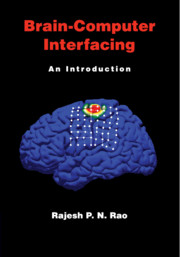Book contents
- Frontmatter
- Dedication
- Contents
- Preface
- 1 Introduction
- Part I Background
- Part II Putting It All Together
- Part III Major Types of BCIs
- 7 Invasive BCIs
- 8 Semi-Invasive BCIs
- 9 Noninvasive BCIs
- 10 BCIs that Stimulate
- 11 Bidirectional and Recurrent BCIs
- Part IV Applications and Ethics
- Appendix Mathematical Background
- References
- Index
- Plate Section
7 - Invasive BCIs
from Part III - Major Types of BCIs
Published online by Cambridge University Press: 05 October 2013
- Frontmatter
- Dedication
- Contents
- Preface
- 1 Introduction
- Part I Background
- Part II Putting It All Together
- Part III Major Types of BCIs
- 7 Invasive BCIs
- 8 Semi-Invasive BCIs
- 9 Noninvasive BCIs
- 10 BCIs that Stimulate
- 11 Bidirectional and Recurrent BCIs
- Part IV Applications and Ethics
- Appendix Mathematical Background
- References
- Index
- Plate Section
Summary
Some of the most important developments in brain-computer interfacing have come from BCIs based on invasive recordings. As reviewed in Chapter 3, invasive recording techniques allow the activities of single neurons or populations of neurons to be recorded. This chapter describes some of the achievements of invasive BCIs in animals and humans.
Two Major Paradigms in Invasive Brain- Computer Interfacing
BCIs Based on Operant Conditioning
A number of BCIs in animals have been based on operant conditioning, a phenomenon discussed in Section 6.2.1. In operant conditioning, an animal receives a reward upon selection of an appropriate action, e.g., pressing a lever. After repetitive pairing, the animal learns to execute the action in anticipation of the reward. In a BCI paradigm, the animal is rewarded if it selectively activates a neuron or population of neurons to move a cursor or prosthetic device in an appropriate manner.
Early BCI Studies
In the late 1960s, in one of the earliest demonstrations of brain- computer interfacing,Eberhard Fetz at the University of Washington in Seattle utilized the idea of operantconditioning to demonstrate that the activity of a single neuron in a primate’s motorcortex can be conditioned to control the needle of an analog meter (Fetz, 1969). Themovement of the needle was directly coupled to the firing rate of the neuron: whenthe needle crossed a threshold, the monkey was rewarded. After several trials, themonkey learned to consistently move the needle past the threshold by increasingthe firing rate of the recorded neuron (Figure 7.1). In this example of operant conditioning, the action (needle movement) that produces reward is coupled to increasedactivity in the recorded neuron (the conditioned response).
Information
- Type
- Chapter
- Information
- Brain-Computer InterfacingAn Introduction, pp. 109 - 148Publisher: Cambridge University PressPrint publication year: 2013
